
Canederli are bread dumplings only found in the north-east of Italy (Trentino-Alto Adige, Friuli and part of Veneto), where they are served as a first course or as a main entree. Variations of canederli are common in all south-eastern Europe, where they are also served as an accompaniment to meat stews and roasts. The word 'canederli', in fact, derives from the German and Austrian 'knödel' (dumplings).
Canederli can be considered part of 'cucina povera' (cuisine of the poor), as they are made of simple and inexpensive ingredients: stale bread moistened with milk and bound with eggs and a small amount of flour. However, the mixture is often enriched with cheese and Speck (a kind of smoked prosciutto also typical of the north-east regions).
There are several variations of this regional dish, the following recipe describes one of the most common: canederli with cheese. Once the dumpling are prepared and boiled, they are either served "dry", with melted butter, or in broth.
Ingredients for 5-6 people
For the dumplings:
- 300 g stale bread, diced (which can be obtained by dicing 450 g of fresh bread and laying it on a perforated tray for 24 hours, covered with a tea towel)
- 225 ml milk
- 3 eggs, lightly beaten
- 60 g white flour
- 3 tablespoons (minced) flat leaf parsley
- 200 g cheese, e.g.: Fontina, Raclette (smoked or plain), or Gouda (smoked or plain), finely diced
- 45 g unsalted butter
- 1 ½ tablespoon olive oil
- 1 onion, finely chopped
- ½ teaspoon salt
- ¼ teaspoon pepper
- ¼ teaspoon nutmeg
- 3 liters of vegetable stock (for boiling)
To serve them "dry":
- 20 g per serving of unsalted butter
- 10 g per serving of grated Parmigiano
- 1 small bunch of chives, thinly sliced
To serve them in broth:
- 1 cup per serving of extra vegetable stock
- Some grated Parmigiano
- Some chives, thinly sliced (optional)
Preparation
- Put the stale bread into a large mixing bowl (1). Add the milk (2), the eggs (3), as well as salt and pepper.
- Mix well and let it rest for at least two hours, covered with a tea towel, in a cool place or in the fridge. Stir occasionally to ensure that the mix absorbs the liquid uniformly.

- After the two hours, add the flour (4), then the parsley (5), and the cheese (6). Mix gently.

- Finely chop the onion (7) and fry it in oil and butter for ten minutes at medium heat, stirring occasionally.
- Let the onion cool off (8), then incorporate it into the mix (9).

- Let the mixture rest for another half an hour covered by a tea towel. It should look uniformly moist and slightly sticky.

- Using your hands, form the canederli by pressing together enough of the mix to make balls the size of a small orange (60 to 80 grams). You should be able produce 14-16 balls out of the entire mix.
- After making each ball, roll it in flour to seal the outside and prevent the canederli from sticking to each other (10).
- When all the canederli are ready, re-roll them into flour and compress them a second time (11).

- Have the vegetable stock in a large pot, well boiling on the stove.
- Place the canederli gently in the pot (12-13), wait until the boil is resumed (14).
- Boil the canederli for 12-15 minutes (they will be floating the whole time), then drain them gently.

If serving the canederli "dry", warm up the butter just enough to melt it. Place 3 canederli into each plate, pour the melted butter on them, then sprinkle with some thin-sliced chives, a generous amount of grated Parmigiano, and some freshly ground black pepper.
If serving the canederli in broth, prepare more vegetable stock (as the one used for boiling will be cloudy because of the flour). Place one or two canederli into each bowl, then pour the broth on them. Finish with some grated Parmigiano and (optional) chives.

Cheese canederli in broth
Note: once boiled, the canederli can be stored in the fridge for up to 3 days, or in the freezer for up to 2 weeks.

